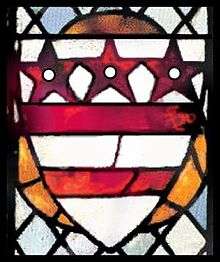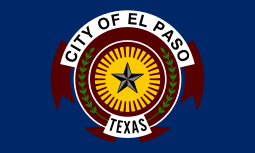Star (heraldry)
In heraldry, the term star may refer to any star-shaped charge with any number of rays, which may appear straight or wavy, and may or may not be pierced. While there has been much confusion between the two due to their similar shape, a star with straight-sided rays is usually called a mullet while one with wavy rays is usually called an estoile.[1]
.jpg)
While a mullet may have any number of points, it is presumed to have five unless otherwise specified in the blazon, and pierced mullets are common; estoiles, however, are presumed to have six rays and (as of 1909) had not been found pierced.[1] In Scottish heraldry, an estoile is the same as in English heraldry, but it has been said that mullet refers only to a mullet pierced (also called a spur revel), while one that is not pierced is called a star.[1]
Terminology
The use of the word star in blazons, and how that charge appears in coat armory, varies from one jurisdiction to another. In Scots heraldry, both star and mullet interchangeably mean a star with five straight rays; the official record from 1673 gives Murray of Ochtertyre azur three Starrs argent ... (Public Register, vol 1 p 188), while the Ordinary of Arms produced by a late 19th century Lyon King of Arms 'modernizes' the original as Az. three mullets arg. .... In Canadian heraldry the usual term is mullet, but there is also the occasional six-pointed star (e.g. in Vol. IV, at p. 274 and in online version of the Canadian Public Register), which is what others would blazon as a six-pointed mullet. The United States Army Institute of Heraldry, the official heraldic authority in the United States, uses the term mullet in its blazons,[2] but elsewhere, as in US government documents describing the flag of the United States and the Great Seal of the United States, the term star is constantly used, and these nearly always appear with five straight-sided points.
The term mullet or molet refers to a star with straight sides, typically having five or six points, but may have any number of points specified in the blazon. If the number of points is not specified, five points are presumed in Gallo-British heraldry, and six points are presumed in German-Nordic heraldry.
Unlike estoiles, mullets have straight (rather than wavy) rays and may have originally represented the rowel of a spur, rather than a celestial star.[3] The term is said to be derived from French molette, a spur-rowel,[3] although it was in use in heraldry even before rowel spurs.[4]
The term estoile refers to wavy-sided stars, usually of six points, though they may also be blazoned with a different number of points, often eight (e.g. "Portsmouth County Council" pictured here), and many variants feature alternating straight and wavy rays (e.g. "Honford" pictured here). The term derives from Old French estoile 'star', in reference to a celestial star (cf. Modern French étoile), from Latin stella 'star'.
 Mullet (English type)
Mullet (English type) Star (German type)
Star (German type) Mullet of six points pierced
Mullet of six points pierced Estoile
Estoile
Classical heraldry

Stars are comparatively rare in European heraldry during the medieval period. An early reference of dubious historicity is reported by Johannes Letzner, who cites Conradus Fontanus (an otherwise unknown authority) to the effect that one Curtis von Meinbrechthausen, a knight of Saxony, in 1169 after committing a murder lost his rank and arms, described as an eight-pointed star beneath a chevron. Examples of stars in a late medieval heraldry of the Holy Roman Empire include those of Wentz von Niederlanstein (1350), Gemm (attested 1352), Geyer von Osterberg (1370), Enolff Ritter von Leyen (d. 1392).[5]
Under the system of cadency in use in England and Ireland since the late 15th century, a third son bears a mullet (unpierced) as a difference.[6]
Stars become much more popular as heraldic charges in the early modern era, especially in then-recent family coats of arms of burghers and patricians, as well as in coats of arms of cities (e.g. Maastricht, Bozen, Kaufbeuren).[7] The coat of arms of Valais originates in the 16th century, when seven stars representing its Seven Tithings were added to the party per pale coat of arms of the Bishop of Sion. Of the higher nobility in Siebmachers Wappenbuch (1605), the landgrave of Hessen and the counts of Waldeck and Erbach have stars in their coats of arms, as do several Swiss knights.[8]
Examples of stars in Heraldry:
 Municipal arms of Thury-sous-Clermont in France.
Municipal arms of Thury-sous-Clermont in France. Coat of arms from the Zimmerische Chronik
Coat of arms from the Zimmerische Chronik Arms of Alfoz de Quintanadueñas.
Arms of Alfoz de Quintanadueñas..svg.png) Coat of arms of the de Béthune family
Coat of arms of the de Béthune family
United States
.svg.png)
Stars are nearly ubiquitous in United States heraldry and vexillology and nearly always appear unpierced with five straight-sided points. In the flag of the United States, each star represents one state.[9] The flag adopted in 1777 is the attributed origin of the thirteen stars, representing the thirteen United States, appearing on the Great Seal since 1780.[10]
A mullet "barbed to chief" appears in the arms of the 240th Signal Battalion of the 40th Infantry Division of the California Army National Guard United States Army.[11]
Examples of stars in US heraldry and vexillology:
 Coat of arms of the U.S. 16th Field Artillery Regiment.
Coat of arms of the U.S. 16th Field Artillery Regiment..svg.png)
 A depiction of Betsy Ross sewing her eponymous flag.
A depiction of Betsy Ross sewing her eponymous flag. Flag of the city of El Paso.
Flag of the city of El Paso.
Modern flags
In the design of modern flags, stars (mullets, usually five-pointed) when standing alone often represent concepts like "unity" or "independence", in the case of the communist star of the flag of the Soviet Union and other communist states the unity under the Communist Party. When arranged in groups, they often enumerate provinces or other components of the nation (such as ethnic groups). In the flags of Nauru and the Marshall Islands, this enumeration is done by the points of a single star rather than by a number of stars.
Some flags of countries on the southern hemisphere show a depiction of the Southern Cross consisting of four or five stars. The star and crescent symbol is found in flags of states succeeding the Ottoman Empire, which used flags with this symbol during 1793-1923.
The twelve stars on the Flag of Europe (1955) symbolize unity.[12]
The green five-pointed star on the Esperanto flag (1890) symbolizes the five inhabited continents.
The 50 stars of the US flag is the largest number on any national flag. The second-largest number of stars on a current national flag is 27, on the flag of Brazil.
The current national flags featuring stars include:
| Flag | Date | # of stars | Points | Stars represent | Description/comment |
|---|---|---|---|---|---|
| 1777; 1960 | 50 | 5 | enumerate US states | originally 13 stars, 50 stars since 1960, see timeline of the flag of the United States | |
| 1955; 1985 | 12 | 5 | ideal | "unity among Europeans". | |
| 1817 | 1 | 5 | ideal | "The star represents a guide to progress and honor" | |
| 1831; 1956 | 1 | 5 | star and crescent | based on the Ottoman flag | |
| 1844; 1936 | 1 | 5 | star and crescent | the Republic of Turkey was established in 1923 and its Flag Law was passed in 1936, declaring the continued use of the Ottoman flag that had been flown since 1844 (an earlier variant with an eight-pointed star dates to ca. 1793). | |
| 1859; 1930 | 8 | 5 | enumerate provinces | various arrangement of the stars in design changes since 1859. Twenty stars during 1859–1863. | |
| 1866 | 5 | 5 | enumerate provinces | based on the flag of the Federal Republic of Central America. The five stars also represent the historical provinces of that state, not subdivisions of Honduras itself. | |
| 1869; 1902 | 4 | 5 | Southern Cross | used as a governmental ensign since 1869, made the official national flag in 1902. Designed by Albert Hastings Markham under a request from Governor George Bowen. | |
| 1889; 1992 | 27 | 5 | enumerate States of Brazil | originally 21 stars, 27 stars since 1992, see Flag of Brazil | |
| 1898 | 3 | 5 | enumerate island groups | the three stars represent the three major geographical island groups that compose the Philippines: Luzon, Visayas and Mindanao. | |
| 1901 | 6 | 7; 5 | Southern Cross; Commonwealth Star | seven-pointed stars for the Commonwealth Star and the main stars of the constellation, plus a smaller five-pointed star representing Epsilon Crucis. Based on the winning design in the 1901 Federal Flag Design Competition. | |
| 1902 | 1 | 5 | ideal | "The white star in the triangle stands for independence". Based on the flag carried by Narciso López in 1850. | |
| 1918 | 1 | 8 | star and crescent | "the eight-pointed star points to the eight letters of the name Azerbaijan (in Arabic script)"[13] | |
| 1925 | 2 | 5 | ideal | "the blue star stands for the purity and honesty of the life of the country; the red star represents the authority and law in the country" | |
| 1928 | 1 | 7 | ideal | "The seven points symbolize the seven verses of the first surah of the Qur’an. The seven points also represent faith in one God, humanity, humility, national spirit, virtue, social justice, and aspiration. The star also stands for the unity of the Arab nation." | |
| 1945 | 1 | 5 | ideal | the Communist Star; "The five-pointed yellow star represents the unity of workers, peasants, intellectuals, traders and soldiers in building socialism" | |
| 1947 | 1 | 5 | ideal | the star represents "light". The crescent and star symbolize progress and light respectively. | |
| 1948 | 1 | 5 | ideal | the Communist Star | |
| 1949 | 5 | 5 | ideal | "Five-starred Red Flag" (五星红旗, Wǔxīng Hóngqí), one large star representing the Communist Party surrounded by four smaller ones depicting the four then social classes | |
| 1949 | 5 | 5 | Southern Cross | ||
| 1954 | 1 | 5 | ideal | "Star of Unity" | |
| 1957 | 1 | 5 | ideal | "the lodestar of African freedom" | |
| 1958 | 1 | 5 | ideal | The star "guides the steps of the Central African people towards freedom and emancipation." | |
| 1958; 1980 | 2 | 5 | enumerate states | The 1958 flag was that of the United Arab Republic. The two stars originally represented Syria and Egypt as member states of that entity. | |
| 1959 | 1 | 5 | star and crescent | ||
| 1960 | 1 | 5 | The five points of the star are said to recall the human ideogram which was displayed in the middle of the flag of the former Mali Federation. | ||
| 1960 | 1 | 5 | ideal | "hope" | |
| 1962 | 1 | 5 | star and crescent | ||
| 1963 | 1 | 14 | enumerate states | a 14-pointed star alongside a crescent, representing the 13 member states plus the federal government | |
| 1965 | 5 | 5 | ideal | five stars alongside a crescent, representing "democracy, peace, progress, justice and equality". According to Lee Kuan Yew, the Chinese population wanted five stars (influenced by the flag of the People's Republic of China) and the Muslim population wanted a crescent moon. | |
| 1967 | 3 | 6 | ideal | "Unity, Work, Progress" | |
| 1967 | 1 | 12 | enumerate tribes | ||
| 1971 | 5 | 5 | Southern Cross | ||
| 1973 | 1 | 5 | ideal | "the Black Star of Africa" | |
| 1974 | 7 | 5 | enumerate parishes | ||
| 1975 | 1 | 5 | ideal | in origin imitating the Communist Star | |
| 1975 | 1 | 5 | ideal | "star of unity" | |
| 1975 | 1 | 5 | ideal | "The star represents the unity of all ethnic groups" | |
| 1975 | 2 | 5 | enumerate islands | ||
| 1976 | 9 | 5 | enumerate islands | The stars are arranged in imitation of the geographic location of the islands of Tuvalu | |
| 1977 | 1 | 5 | ideal | "The red star signifies the unity of the diverse state." | |
| 1977 | 5 | 5 | enumerate islands | ||
| 1978 | 10 | 5 | enumerate parishes | ||
| 1979 | 1 | 24 | enumerate districts | the points of the stars enumerate the electoral districts | |
| 1979 | 4 | 5 | enumerate states | Based on the Flag of the US Trust Territory of the Pacific, each star represents a constitutional State (Yap, Chuuk, Pohnpei, and Kosrae) | |
| 1983 | 2 | 5 | ideal / enumerate islands | "hope and liberty, or Saint Kitts and Nevis" | |
| 1984 | 1 | 5 | ideal | "the guiding light of the revolution" | |
| 1990 | 2 | 6 | morning star | The stars are part of the coat of arms of Croatia. One star is part of the coat of arms of the Illyrian movement, and the other is part of the coat of arms of Slavonia. | |
| 1991 | 3 | 6 | ideal | "democracy", inspired by the historical coat of arms of the Counts of Celje[14] | |
| 1991 | 12 | 5 | ideal | a crescent and twelve stars, representing the "ancient calendar cycle" | |
| 1992 | 7 | 5 | seven stars on heaven's mountains | ||
| 1992 | 10 | 5 | enumerate islands | ||
| 1998 | 8 ("∞") | 5 | ideal | a diagonal line of seven five-pointed stars, plus two half-stars cut off by the flag boundary. The stars represent "Europe" and are intended to be "infinite" in number. | |
| 2001 | 4 | 5 | enumerate islands | four stars alongside a crescent | |
| 2001 | 5 | 5 | enumerate provinces | five stars alongside a crescent | |
| 2002 | 1 | 5 | ideal | "the light that guides" | |
| 2005 | 1 | 5 | ideal | "the Star of Bethlehem, represents the unity of the states of South Sudan" | |
| 2007 | 1 | 5 | ideal | derived from the flag of Congo Free State (1885) | |
| 2010 | 1 | 5 | ideal | "unity" |
Not bearing heraldic stars as such, the 1915 Flag of Morocco and the 1996 flag of Ethiopia have a pentagram each, and the 1948 flag of Israel a hexagram or "star of David". The 1962 Flag of Nepal has what would technically be described as a 12-pointed mullet, but is intended to depict the Sun.
See also
- Rayed solar symbol
- Star and crescent
References
- Fox-Davies, Arthur Charles; Graham Johnston (1909). A Complete Guide to Heraldry. pp. 295–296.
- "172 Support Battalion" The Institute of Heraldry
- Volborth, Carl Alexander (1981). Heraldry: Customs, Rules and Styles. Poole, England: Blandford Press. p. 48. ISBN 0-7137-0940-5.
- "Mullet". Pimbley's Dictionary of Heraldry. 2008-03-12. Retrieved 2008-02-07.
- Christian Friedrich August von Meding, Nachrichten von adelichen Wapen, 1786.
- Volborth, 1981. p. 80.
- Siebmachers Wappenbuch (1605), p. 219-224
- Siebmachers Wappenbuch (1605) pp.197-204
- "Our Flag" (PDF). United States Government Printing Office. 1998. S. Doc 105-013. Retrieved 2009-02-07.
- "The Great Seal of the United States" (PDF). U.S. Department of State, Bureau of Public Affairs. Retrieved 2009-02-07.
- The Institute of Heraldry, ed. (2010-11-01). "240th Signal Battalion". Department of the Army. Retrieved 2010-11-01.
- "The European Flag, Europa (web portal)". 4 August 2007. Retrieved 3 August 2014.
- Сабухи Ахмедов, Государственный флаг Азербайджанской Республики ("The national flag of the Republic of Azerbaijan") (in Russian), citing Мярданов М., Гулийев Я., Азярбайъан Республикасынын дювлят рямзляри. Б., 2001, pp. 74-75.
- "Državni simboli niso čarovnija, so pa silen potencial" [National Symbols are not Magic, but Are a Strong Potential]. Primorske.si (in Slovenian). Primorske novice, d.o.o. 26 June 2011. ISSN 1580-4747.
External links
| Wikimedia Commons has media related to Flags with stars. |
| Wikimedia Commons has media related to Stars in heraldry. |